Guntur
| Guntur గుంటూరు گنٹور Garthapuri | |
|---|---|
| City | |
| Etymology: Garthapuri (Tank Village) | |
 Guntur | |
| Coordinates: 16°18′03″N 80°26′34″E / 16.3008°N 80.4428°ECoordinates: 16°18′03″N 80°26′34″E / 16.3008°N 80.4428°E | |
| Country | India |
| State | Andhra Pradesh |
| District | Guntur |
| Mandal | Guntur |
| Founded | 18th century AD |
| Founded by | French |
| Government | |
| • Body | Guntur Municipal Corporation[1] |
| • Mayor | None |
| • Municipal Commissioner | S. Nagalakhsmi |
| • Member of Parliament | Galla Jayadev |
| Area[2] | |
| • Total | 168.41 km2 (65.02 sq mi) |
| Elevation | 30 m (100 ft) |
| Population (2011)[3] | |
| • Total | 7,43,354 |
| • Rank |
64th (India) 2nd by Area and 3rd by Population (Andhra Pradesh) |
| • Density | 4,400/km2 (11,000/sq mi) |
| Demonym(s) | Gunturian |
| Languages | |
| • Official | Telugu |
| Time zone | IST (UTC+5:30) |
| PIN | 522 xxx |
| Telephone code | +91-863 |
| Vehicle registration | AP 07; AP 08 |
| Sex ratio | 1016[4] ♂/♀ |
| Lok Sabha constituency | Guntur |
| Urban planning agency | APCRDA |
| Website |
guntur |
Guntur (![]() pronunciation ); is a city in the Guntur district of the Indian state of Andhra Pradesh. It is a municipal corporation and the administrative headquarters for Guntur district.[5] It is also the mandal headquarters of Guntur mandal in Guntur revenue division.[6] The city is the second largest by area and third most populous in the state.[3] with a population of 743,354 and with an urban agglomeration population of 1,028,667.[3][7] The city is situated on the plains and located 40 miles (64 km) to north of the Bay of Bengal. River Krishna is the main source of water for the city through channels and tributaries.[8]
pronunciation ); is a city in the Guntur district of the Indian state of Andhra Pradesh. It is a municipal corporation and the administrative headquarters for Guntur district.[5] It is also the mandal headquarters of Guntur mandal in Guntur revenue division.[6] The city is the second largest by area and third most populous in the state.[3] with a population of 743,354 and with an urban agglomeration population of 1,028,667.[3][7] The city is situated on the plains and located 40 miles (64 km) to north of the Bay of Bengal. River Krishna is the main source of water for the city through channels and tributaries.[8]
The city is part of Andhra Pradesh Capital Region[9] and Vishakhapatnam-Guntur Industrial Region, a major industrial corridor in India.[10] It is also a Tier-II city as per Government of India and the headquarters to many state departments and agencies and is renowned for education, business, e-commerce industry, and agriculture.[11][12] It exports chilli pepper, cotton, tobacco and also it is also the largest producer of chilies in the country.[13]
Etymology
The earliest reference to the present name of the city can be dated back to the period of Ammaraja–I (922-929 CE), the Vengi Eastern Chalukyan King. It also has its appearance in another two inscriptions dated 1147 A.D and 1158 A.D.[14] In Sanskrit, the name of Guntur was referred as Garthapuri, which translates to Tank village during the French occupation.[15]
History
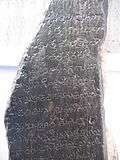
The earliest recorded reference of Guntur comes from the Idern plates of Ammaraja I (922–929 CE), the Vengi Chalukyan king. French astronomer, Pierre Janssen observed the Solar eclipse of 18 August 1868 and discovered helium, from Guntur in Madras State, British India.[16][17] The inscriptions stones in the Agastyeshwara temple in 'Naga Lipi' (an ancient script) dates back to about 1100 CE. It is considered one of the most famous temples in the city. It is said that Agastya built the temple in the last Treta Yuga around the swayambhu linga and hence it has this name. The 'Nagas' were said to have ruled the region at that time. The region has been historically known for Buddhism and the first Kalachakra ceremony performed by Gautama Buddha himself.[18] The place of Sitanagaram and the Guttikonda caves are referred in the ancient texts (Vedic puranas) going back to the Treta Yuga and Dwapara Yuga (Traditional time scale: 1.7 to 0.5 million years ago, Ref).[19]
With the arrival of the Europeans in the late sixteenth century the city attained national and international significance. The French shifted their headquarters from Kondavid Fort to here in 1752, probably because of the ample availability of water due to the two large tanks. This settlement formed the nucleus of the modern city. The Nizams and Hyder Ali also ruled the city until it came under British rule in 1788. It was made the headquarters of a district named after it that was abolished in 1859, only to be reconstituted in 1904. The city rapidly became a major market for agricultural produce from the surrounding countryside due to the opening of the railway link in 1890. The expansion continued post independence as well and was concentrated in what is now called "New Guntur", with many urban areas such as Brodipet, Arundalpet and suburban areas like Pattabhipuram, Chandramouli Nagar, Sita Rama nagar, Brindavan Gardens, etc.
Geography
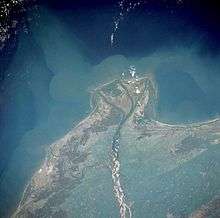
Guntur Plains: Guntur is located at 16°17′N 80°26′E / 16.29°N 80.43°E.[20] It has an average elevation of 33 m (108 ft) and is situated on the plains. There are a few hills in the surrounding suburban areas. The city is located around 40 miles (64 km) to the west of the Bay of Bengal on the east coast of India. The Krishna delta lies partly in the Guntur district. There are other smaller rivers and channels in the region such as Guntur Channel, Chandravanka, Naagileru, Guntur Branch Canal[21] etc.
As quoted in NASA's website "it is typical of the wider deltas along the southeast coast of India (known as the Coromandel Coast).[22] The braided stream channels, broad floodplain, and extensive sandbars suggest that this part of the Krishna River flows through relatively flat terrain and carries a substantial amount of sediment, especially during the monsoon season." Image Website of NASA of the Guntur City and District/Region of India. With the ocean on the top portion of the image, the actual location of the city is on the bottom right side portion of the image.
Climate
As per Köppen-Geiger climate classification system the climate in Guntur is tropical (Aw). The average temperature is warm to hot year-round. The summer season (especially during May/June) has the highest temperatures, but these are usually followed by summer monsoon rains. The winter season (from October to February) is the most enjoyable with a pleasant climate. Winter months may feature more rainfall than summer but there are dry spells during the winter season. The wettest month is July. The average annual temperature is 28.5 C and annual rain fall is about 905 mm. Rain storms and hurricanes are common in the region during the rainy season, which starts with the monsoons in early June. Hurricanes may occur any time of the year, but occur more commonly between May and November.
| Climate data for Guntur City | |||||||||||||
|---|---|---|---|---|---|---|---|---|---|---|---|---|---|
| Month | Jan | Feb | Mar | Apr | May | Jun | Jul | Aug | Sep | Oct | Nov | Dec | Year |
| Average high °C (°F) | 29.8 (85.6) |
32.2 (90) |
34.7 (94.5) |
36.8 (98.2) |
39.3 (102.7) |
37.5 (99.5) |
33.3 (91.9) |
32.9 (91.2) |
32.8 (91) |
31.7 (89.1) |
30.3 (86.5) |
29.2 (84.6) |
33.38 (92.07) |
| Daily mean °C (°F) | 24.4 (75.9) |
26.2 (79.2) |
28.7 (83.7) |
31.4 (88.5) |
33.6 (92.5) |
32.6 (90.7) |
29.5 (85.1) |
29.2 (84.6) |
29 (84) |
28 (82) |
25.7 (78.3) |
24.1 (75.4) |
28.53 (83.33) |
| Average low °C (°F) | 19 (66) |
20.3 (68.5) |
22.8 (73) |
25.8 (78.4) |
28 (82) |
27.7 (81.9) |
25.7 (78.3) |
25.5 (77.9) |
25.3 (77.5) |
24.2 (75.6) |
21.1 (70) |
19 (66) |
23.7 (74.59) |
| Average precipitation mm (inches) | 1 (0.04) |
4 (0.16) |
6 (0.24) |
14 (0.55) |
56 (2.2) |
115 (4.53) |
171 (6.73) |
161 (6.34) |
151 (5.94) |
159 (6.26) |
58 (2.28) |
10 (0.39) |
906 (35.66) |
| Source: Climate-Data.org (altitude: 26 m)[23] | |||||||||||||
Geography
It is situated on the plains and located 40 miles (64 km) to north of the Bay of Bengal. It is surrounded by small hills and Perecherla Reserve Forest on the west. River Krishna is the main source of water for the city through channels and tributaries.[24]
Demographics
In the 1961 census, Guntur had a population of 187,122 and increased to 516,461 in 2001, which shows a considerable growth during the last 5 decades. As of 2011 census, the city had a population of 651,382. It then increased to 7,43,354 after expansion, constituting 371,727 males and 3,71,612 females —a sex ratio of approximately 1000 females per 1000 males, higher than the national average of 940 per 1000.[3][25] The urban agglomeration population of the city is projected to be approximately, 1,028,667.[7]
Telugu is the main language of communication in the city. One of the earlier forms of Telugu language can be noticed in this region.[26] Most of the Muslims in the city speak Urdu as their mother tongue.[27] One of the purportedly lost tribes of Israel called Bene Ephraim, has its presence in Guntur, with a Jewish synagogue as well.[28][29]
Governance


Civic administration
In 1866, Guntur was made a municipality with a population of about 25,000. It was upgraded to III (1891), I Grade (1917), special grade (1952) and selection grade in 1960. Later, in 1994 it was made a "Municipal Corporation". In 1995, the first election of the Municipal Corporation was conducted.[30] In the year 2012, the city limits were expanded by merging ten surrounding villages into the Guntur Municipal Corporation.[31] The present commissioner is S. Nagalakhsmi.[32]
The city is one among the 31 cities in the state to be a part of water supply and sewerage services mission known as Atal Mission for Rejuvenation and Urban Transformation (AMRUT).[33] In 2015, as per the Swachh Bharat Abhiyan of the Ministry of Urban Development, Guntur Municipal Corporation was ranked 70th in the country.[34]
The High Court was in Guntur after the separation from the erstwhile Madras State,[35] which was later moved to Hyderabad after the formation of Andhra Pradesh.[36][37] Guntur Urban and Rural police offices oversees the law and order for the city and the rural areas surrounding it.[38] The city is also the headquarters for Agricultural Marketing Department,[11] NCC Group[38] and also hosts one of the Indian Army recruitment and training centers.[39]
Healthcare
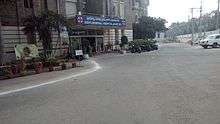
The region of Guntur is one of the medical hubs in India. It offers wide access to top medical care at reasonable prices and has a variety of charity hospitals that serve as a safety net for the destitute. It boasts major medical facilities (super speciality hospitals) and related research institutions. The General Hospital provides free health care to people across the coastal districts. The Sankar Eye Hospital,[40]
Economy
Agro exports
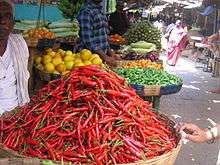
Guntur is a major commercial centre for exports of Cotton, tobacco and chilli to different parts of the world. The city hosts the largest Asian market[41] for red chillies. The Tobacco Board, India, a part of the Government of India, is headquartered in Guntur. The chilies that are grown in this region are the spiciest.[42] One of the first of its kind, a global 'Spice Park' is currently being set up in the area.[43] Cotton produced is used in making some of the finest sarees in India.[44]
Industrialization
The industrial development in the Guntur Region is of medium scale. On a positive note, the region has minimal industrial and related pollution as compared to other major cities in the country. It has a large skilled and educated workforce. Some of the industries in the area are: textile mills, silk, dairy, cement, chemical and Biotechnology, fertilizers, jute, granite, diamond and other ore processing (Hindustan Zinc Limited). There are many small to medium scale industries such as Bharathi Soap Works, Tulasi Seeds, Crane Group, Nuziveedu Seeds Limited(NSL), Textiles with spinning mills at Edlapadu, Ginning mills at Gurazla and Garmenting at Budampadu. Eastern Condiments has Chillies processing centre at Narakoduru. Textile Hub is being developed on the southwestern side of the city,[45] and the government is also encouraging the setting up of new industries. Another ongoing project is an 8.50 billion IT park in Guntur outskirts.[46]
Culture

The city residents are referred as Gunturians.[47] Traditional drama and theatrical events also have their presence in the city.[48] The city has various religious presence and hence, many festivals such as, Eid al-Adha by Muslims;[49] Hindu festivals of Diwali, Holi;[50][51] and Christmas by Christians;[52] etc., and many more.
Cuisine
The South Indian breakfast varieties such as, Idli, Dosa etc., are preferred mostly.[53] The Red chilli biryani is one of the most distinguished food item of the city.[54] Guntur Sannam, a chilli variety was registered as one of the geographical indication from Andhra Pradesh under the Geographical Indications of Goods (Registration and Protection) Act, 1999.[55]
Cityscape
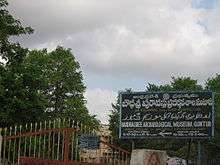
The major commercial and residential areas in the city include the Arundelpet, Lakshmipuram and Brodipet. Navabharath Nagar, Pattabhipuram, Shyamla Nagar and Vidya Nagar etc., are some of the other areas in the city.[56] Autonagar, Gorantla, Peda Palakaluru, Nallapadu etc. are some of the other areas of the city.[57]
The city has many parks, museums, temples, nature conservation sites, forts, resorts and caves. The Jinnah Tower is one of the iconic structure on Mahatma Gandhi Road, one of the important centre of the city.[58] There are seventeen parks in the city with some of them maintained by the municipal corporation.[59]
Transport
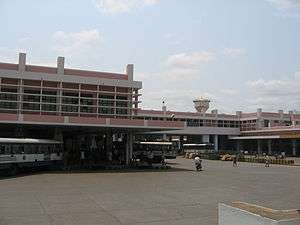

Public transport
APSRTC operates buses to various destinations from NTR bus station of the city. It has also introduced city bus services from the city to the nearby destinations of Pedakakani, Namburu, Yanamadala and Chebrolu.[60] Other local transport of the city are private mini buses and auto-rickshaws.[61]
Roadways
The city is well connected to the major destinations through various national and state highways. National Highway 16 bypasses the city, which is also a part of Asian Highway 45 and Golden Quadrilateral.[62] The highway is connected with the Mahatma Gandhi Inner Ring Road, encircling the city.[63] The State Highway 2 connects the city with Macherla and State Highway 48 with Bapatla and Chirala.[64][65] The Guntur-Parchoor road is a part of the core road network of the district, that connects it with the Parchur.[66] The city has a total road length of 853.00 km (530.03 mi).[67]
Railways
Guntur Junction and New Guntur are classified as an A and E category stations respectively in the Guntur railway division of South Central Railway zone.[68] These two railway stations of the city are used for rail transport.[69] Nallapadu and Perecherla are the other two satellite stations.[70] Rail Vikas Bhavan in the city is the headquarters of Guntur railway division.[71][72]
Air
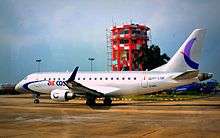
Vijayawada Airport is located at Gannavaram. It is the nearest Domestic Airport to Guntur city. It connects to the nearest International Airport Hyderabad and also to other places like Bangalore, Coimbatore, Chennai, Delhi, Visakhapatnam, Tirupati and Kadapa. The domestic airport is served by Air India, SpiceJet, TruJet and Air Costa. A plan for its expansion has been proposed which will enable the landing of larger aircraft and also provide night landing facilities. Government of Andhra Pradesh is planning to Build a new Greenfield Airport near City.
Education and research

The primary and secondary school education is imparted by government, aided and private schools, under the School Education Department of the state.[73][74] As per the school information report for the academic year 2015–16, the city limits (including the merged villages) have more than one lakh students enrolled in over 400 schools.[75][76]
The Central Board of Secondary Education, Secondary School Certificate or the Indian Certificate of Secondary Education are the different types of syllabus followed by different schools. The medium of instruction followed by schools are English, Telugu and Urdu.[77][78]
Government colleges and institutions include, Guntur Medical College,[79] Government Junior College for Girls.[80] There exists one residential college under APRJC, ten private aided, two co-operative and many private aided colleges.[80] JKC College, RVR & JC College of Engineering, Government College for Women and St. Joseph's College of Education for Women are the autonomous colleges approved under Universities Grant Commission scheme.[81] The Acharya N. G. Ranga Agricultural University at Lam village near the city is administered from Gorantla area of the city.[82]
There are also research centres related to different fields such as, Regional AGMARK laboratory,[83] regional station of Central Tobacco Research Institute of Indian Council of Agricultural Research.[84]
Sports
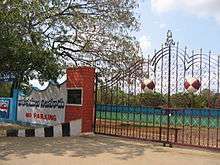
Sporting infrastructure of the city include several venues for many sports such as, Brahmananda Reddy stadium for Tennis, Badminton, Volleyball, Athletics, Gymnastics, Swimming;[85][86][87] NTR Municipal Indoor stadium for Table Tennis and Volleyball;[88][89] and also other sports such as Boxing.[90] The city has hosted sporting events such as, All India Senior Tennis Association,[91] All India Sub Junior Ranking Badminton Tournament,[92] All India Invitation Volleyball Tournament,[89] Ganta Sanjeeva Reddy Memorial Trophy,[93] Inter-district Master Aquatic Championship[94] etc. The headquarters of Sports Auuthority of Andhra Pradesh is planned to be set up at the city.[95]
International sports personalities from the city include: cricketer Ambati Rayudu;[96] badminton player Srikanth Kidambi, who won the Super Series title in China[97] and also finished as a quarter finalist at the 2016 Summer Olympics.[98]
See also
References
- ↑ "Governing body". Guntur Municipal Corporation. Retrieved 10 June 2014.
- ↑ "The Case of Guntur, India" (PDF). DReAMS – Development of Resources and Access to Municipal Services. p. 1. Retrieved 15 June 2015.
- 1 2 3 4 "Guntur city population is 7,43,354 as per 2011 Census". The Hindu. Guntur. 26 May 2013. Retrieved 12 October 2014.
- ↑ "Sex Ratio" (PDF). 4 September 2007.
- ↑ "Adminsistrative divisions of Guntur district" (PDF). guntur.nic.in. Retrieved 16 January 2015.
- ↑ "Guntur District Mandals" (PDF). Census of India. pp. 83,110. Retrieved 19 January 2015.
- 1 2 "Demography". National Informatics Centre. Retrieved 30 April 2015.
- ↑ "Guntur Water source" (PDF). 7 July 2016.
- ↑ "AP Capital Region Development Authority comes into being". The Hindu. Hyderabad. 31 December 2014. Retrieved 11 February 2015.
- ↑ "Industrial Corridor". Retrieved 16 May 2014.
- 1 2 "Departments moving to new Capital Region". The Hindu. 16 June 2016.
- ↑ "Guntur region listed a major E-Commerce hub in the country". Deccan Chronicle. 16 August 2013.
- ↑ "Chilli Production, Business Standard". Mumbai. 11 January 2011.
- ↑ "Guntur History". National Informatics Centre. Retrieved 27 July 2014.
- ↑ "About Guntur". VGTMUDA. Capital Region Development Authority. Archived from the original on 21 August 2015. Retrieved 3 March 2016.
- ↑ Leggett, Hadley (18 August 2009), Aug. 18, 1868: Helium Discovered During Total Solar Eclipse, wired.com, retrieved 18 March 2010
- ↑ "Comptes rendus hebdomadaires des séances de l'Académie des sciences", C. R. Hebd. Acad. Sci. Paris, 67: 836–41, 1868
- ↑ "Kālacakra history". kalacakra.org.
- ↑ ":::- WELCOME TO GUNTUR DISTRICT OFFICIAL WEBSITE -:::".
- ↑ "Falling Rain Genomics-Guntur". Falling Rain Genomics Inc.
- ↑ "Guntur irrigation". Government of India.
- ↑ "KRISHNA R/DELTA, COAST". Gateway to Astronaut Photography of Earth. Archived from the original on 14 July 2014. Retrieved 15 November 2015.
- ↑ "Climate: Guntur – Climate graph, Temperature graph, Climate table". Climate-Data.org. Retrieved 16 February 2016.
- ↑ "Guntur Water source" (PDF). 7 July 2016.
- ↑ "Sex Ratio". The Registrar General & Census Commissioner, India. Retrieved 3 September 2014.
- ↑ "Old poetry about the city" (PDF). Old Poetry. 27 August 2012.
- ↑ "Language in India". languageinindia.com.
- ↑ Sadok Yacobi. "Bene Ephraim of Andhra Pradesh, South India". kulanu.org. Retrieved 24 May 2015.
- ↑ "The Children of Ephraim: being Jewish in Andhra Pradesh". Anthropology Today. 26. Retrieved 24 May 2015.
- ↑ "Gunturmunicipalcorporation.org". GMC-IT Wing,2002.
- ↑ "Merger of gram panchayats in Guntur Municipal Corporation" (PDF). Guntur Municipal Corporation. Municipal Administration & Urban Development Department. Retrieved 22 September 2015.
- ↑ "Present & Ex-Commissioners". Guntur Corporation. Retrieved 13 February 2016.
- ↑ Vadlapatla, Sribala (11 August 2015). "Amaravati among 31 AP cities selected for Amruth development". The Times of India. Hyderabad. Retrieved 18 December 2015.
- ↑ Sandeep Kumar, S (10 August 2015). "Small towns fare better in Swachh Bharat rankings". The Hindu. Vijayawada. Retrieved 30 March 2016.
- ↑ "Former High Court July 06, 1954". The Hindu. Chennai, India. 6 July 2004.
- ↑ "High Court bench requirement". The Hindu. Chennai, India. 25 February 2006.
- ↑ "Telangana advocates nudge CJI on HC bifurcation". Deccan Chronicle. Hyderabad. 10 April 2016.
- 1 2 "Celebrations a big hit in Guntur". The Hindu. 22 June 2016. Retrieved 24 June 2016.
- ↑ "Army recruitment rally". The Hindu. Guntur. 17 January 2008. Retrieved 17 January 2008.
- ↑ "Sankara Eye Hospital goes hi-tech". The Hindu. Chennai, India. 1 March 2007.
- ↑ "Chillies lose sting, exports & Guntur markets only hope". Online edition of the Economic Times. The Economic Times. 17 May 2007. Retrieved 21 June 2007.
- ↑ "Guntur Chillies". Online edition of Outlook magazine-free registration required. Retrieved 1 August 2007.
- ↑ "`Spices Park' to come up in Guntur". The Hindu. Chennai, India. 4 February 2007.
- ↑ "Guntur & Mangalagiri sarees". SariSafari.com. Retrieved 23 August 2007.
- ↑ "Guntur set to become a textile hub". The Hindu. Chennai, India. 25 April 2006.
- ↑ "Slowdown shadow on SEZ?". The Hindu. Chennai, India. 29 October 2008.
- ↑ "Braving chill, Gunturians walk with enthusiasm". The Hindu. Guntur. 25 January 2016. Retrieved 3 March 2016.
- ↑ "Folk art fete in Guntur". The Hindu. Chennai, India. 7 August 2006.
- ↑ "Nation Celebrates Eid-ul-Adha with Religious Fervour". Sakshipost. 13 September 2016. Retrieved 4 October 2016.
- ↑ "Diwali celebrated with gaiety in AP, Telangana". The Hans India. Retrieved 4 October 2016.
- ↑ "Gaiety, colour, fervour mark Holi festivities". The Hindu. 24 March 2016. Retrieved 4 October 2016.
- ↑ "CM Chandrababu for Guntur today". The Hans India. Retrieved 4 October 2016.
- ↑ Ganguly, Nivedita (6 May 2016). "A delightful dosa fare". The Hindu. Retrieved 4 October 2016.
- ↑ Ganguly, Nivedita (29 May 2015). "Traditional flavours of Andhra". The Hindu. Retrieved 4 October 2016.
- ↑ "Geographical Indication". The Hans India. Retrieved 4 October 2016.
- ↑ Samuel Jonathan, P (24 July 2014). "Guntur looking skyward". The Hans India. Vijayawada. Retrieved 28 February 2016.
- ↑ "Guntur Inner Ring Road Inaugurated by Kiran". The New Indian Express. 17 February 2014. Retrieved 3 March 2016.
- ↑ "Blog: Finding Kamala Nehru in Pakistan, Jinnah in Guntur". NDTV. 20 May 2015. Retrieved 23 September 2016.
- ↑ "Other parks in Guntur city !!". Guntur Municipal Corporation. Retrieved 23 September 2016.
- ↑ "New fleet of city buses in Guntur". The Hindu. Guntur. 20 August 2015. Retrieved 16 February 2016.
- ↑ "RTC to introduce bus services in Guntur city". Deccan Chronicle. 26 November 2014. Retrieved 4 June 2016.
- ↑ "NHAI Under Pressure to Lay Another Bypass Road". The New Indian Express. 25 August 2014. Retrieved 4 June 2016.
- ↑ "Guntur Inner Ring Road Inaugurated by Kiran". The New Indian Express. 17 February 2014. Retrieved 4 June 2016.
- ↑ Samuel Jonathan, P (8 October 2015). "Nizampatnam backwaters beckon adventure geeks". The Hindu. Guntur. Retrieved 29 February 2016.
- ↑ "Road Maps". Roads and Buildings Department. Government of Andhra Pradesh. Retrieved 29 February 2016.
- ↑ ":: APRDC ::". Andhra Pradesh Road Development Corporation. Roads and Buildings Department. Retrieved 9 November 2016.
- ↑ "Details of Roads in each ULB of Andhra Pradesh". Municipal Administration and Urban Development Department. Retrieved 27 June 2016.
- ↑ "Evolution of Guntur Division" (PDF). South Central Railway. p. 3. Retrieved 30 November 2015.
- ↑ "Connected Guntur will spur growth". Deccan Chronicle. 21 December 2015. Retrieved 4 June 2016.
- ↑ "Guntur misses metro rail project". Deccan Chronicle. 22 September 2014. Retrieved 28 August 2016.
- ↑ "Guntur Division". gunturdivision.blogspot.in. Retrieved 4 March 2016.
- ↑ "Rediff On The NeT: Paswan to inaugurate new railway division at Guntur".
- ↑ "School Education Department" (PDF). School Education Department, Government of Andhra Pradesh. Retrieved 7 November 2016.
- ↑ "The Department of School Education – Official AP State Government Portal | AP State Portal". www.ap.gov.in. Retrieved 7 November 2016.
- ↑ "School Information Report". Commissionerate of School Education. Government of Andhra Pradesh. Retrieved 8 November 2016.
- ↑ "Student Information Report". Commissionerate of School Education. Child info 2015–16, District School Education – Andhra Pradesh. Retrieved 8 November 2016.
- ↑ "74 GMC schools switch to English medium – Times of India". The Times of India. Retrieved 23 September 2016.
- ↑ Mallikarjun, Y. (29 February 2016). "Classrooms in State-run schools set to go digital". The Hindu. Retrieved 23 September 2016.
- ↑ Reporter, Staff (17 February 2016). "MCI team inspects Guntur Medical College". The Hindu. Retrieved 27 September 2016.
- 1 2 "List of colleges in Guntur district" (PDF). Board of Intermediate Education. Retrieved 27 September 2016.
- ↑ "Autonomous colleges list" (PDF). Universities Grants Commission. Retrieved 27 September 2016.
- ↑ Reporter, Staff (14 June 2016). "Marketing Department moves to capital region". The Hindu. Retrieved 27 September 2016.
- ↑ Regulations, instructions, manuals and records held by it or "Information on Right to Information Act, 2005 Pertaining to Directorate of Marketing & Inspection" Check
|url=value (help). Agricultural Marketing. Retrieved 4 October 2016. - ↑ Bureau, Our (22 September 2014). "Tobacco Board sets export target at Rs 10,000 cr". The Hindu Business Line. Retrieved 4 October 2016.
- ↑ Reporter, Staff (9 June 2013). "Nod for swimming pool at BR stadium in Guntur". The Hindu. Retrieved 29 September 2016.
- ↑ Jonathan, P. Samuel (26 May 2016). "Kids learn the basics of tennis". The Hindu. Retrieved 29 September 2016.
- ↑ "Guntur athletic trials". The Hindu. 10 September 2015. Retrieved 29 September 2016.
- ↑ "Place for TT at NTR indoor stadium". The Hindu. 16 July 2016. Retrieved 29 September 2016.
- 1 2 Reporter, Staff (25 February 2016). "Volleyball tournament off to a smashing start in Guntur". The Hindu. Retrieved 29 September 2016.
- ↑ Reporter, Staff (6 November 2014). "Young boxers from Guntur district win laurels". The Hindu. Retrieved 29 September 2016.
- ↑ Reporter, Staff (1 February 2016). "AISTA tennis tourney gets under way". The Hindu. Retrieved 29 September 2016.
- ↑ Reporter, Staff (20 October 2015). "Badminton tourney gets under way". The Hindu. Retrieved 29 September 2016.
- ↑ "Swimming championships from July 10 – Times of India". The Times of India. 25 June 2015. Retrieved 29 September 2016.
- ↑ "Inter-district Master Aquatic Championship inaugurated.". The Hans India. 10 July 2016. Retrieved 29 September 2016.
- ↑ Shridharan, J. r (3 March 2016). "Guntur may become SAAP headquarters". The Hindu. Retrieved 29 September 2016.
- ↑ "Ambati Rayudu". Cricinfo. Retrieved 29 September 2016.
- ↑ Jonathan, P. Samuel (17 November 2014). "Guntur lad scripts history in badminton". The Hindu. Retrieved 29 September 2016.
- ↑ Bhatt, Shephali (25 September 2016). "Srikanth Kidambi: On losing temporary limelight and keeping permanent focus on the game – The Economic Times". The Economic Times. Retrieved 29 September 2016.
External links
| Wikimedia Commons has media related to Guntur. |
| Wikivoyage has a travel guide for Guntur City. |
